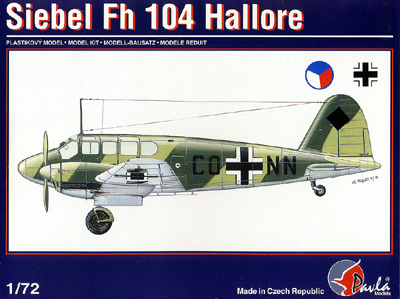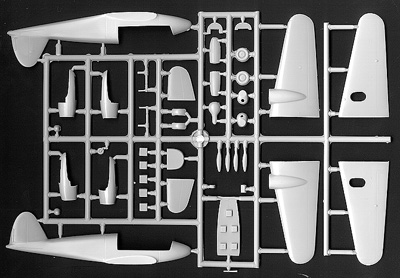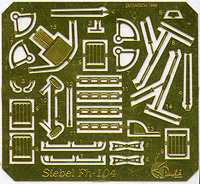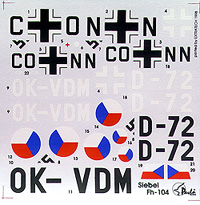
Pavla 1/72 Siebel Fh 104 "Hallore"
By Chris Banyai-Riepl
Overview
The Siebel Fh 104 was first designed as a small, fast mail transport in the 1930s, and it rapidly developed into a great general liaison aircraft and squadron hack, with such personalities as Adolf Galland and Ernst Udet flying them. Those who wanted to build a model of this interesting plane had to resort to tracking down an obscure vacuform and build one from that. Well, not any more. Pavla Models has put out an incredible example of this plane, and it is full of detail.
 The Kit
The Kit
The parts are all on one tree (except for the vacuformed canopy and photoetch parts), and are molded in a nice light gray. There is very little surface detail present, and what is there is recessed. The detail for the kit comes from the etched brass fret, which contains a good set of interior parts, including seats, a map table, instrument panel (with a dial negative to sit behind it), and rudder pedals. This detail is nice, but you will probably want to add more, as there is a lot visible through that greenhouse canopy.
 The engines are reasonably well done, with some flash covering the vents on the nose piece and etched brass exhaust ports. The propellers, while reasonably accurate, are difficult as they are provided as individual blades and hubs, with no locating pegs or holes. It's entirely up to the modeler to make sure that the blades are set properly when gluing them, both in front and side alignment and in pitch. Not an easy task without building a jig of some sort.
The engines are reasonably well done, with some flash covering the vents on the nose piece and etched brass exhaust ports. The propellers, while reasonably accurate, are difficult as they are provided as individual blades and hubs, with no locating pegs or holes. It's entirely up to the modeler to make sure that the blades are set properly when gluing them, both in front and side alignment and in pitch. Not an easy task without building a jig of some sort.
The landing gear is done very well, being a well thought out blend of plastic and photoetch. The struts and mudflaps are plastic, with the mudflap supports being photoetch, along with the oleo scissors. This results in a very sturdy gear assembly, with plenty of sharp detail. It will take a little work to build, but it will really pay off.
 The decals are printed by Propagteam, so you are guaranteed thin decals with perfect alignment. The blue in the Czech markings seems a bit bright, but it may tone down when laid over the dark green camouflage. Swastikas are provided for the German version, but they are cut in half for the European market. Still, it's better than not having them. With the wide variety of Fh104s out there, you can have a heyday with color schemes. Udet had a red one, and Galland's featured his Mickey Mouse emblem on both engines and the fuselage. The big difficulty will be finding decent pictures of this plane, as it wasn't a very common one to photograph.
The decals are printed by Propagteam, so you are guaranteed thin decals with perfect alignment. The blue in the Czech markings seems a bit bright, but it may tone down when laid over the dark green camouflage. Swastikas are provided for the German version, but they are cut in half for the European market. Still, it's better than not having them. With the wide variety of Fh104s out there, you can have a heyday with color schemes. Udet had a red one, and Galland's featured his Mickey Mouse emblem on both engines and the fuselage. The big difficulty will be finding decent pictures of this plane, as it wasn't a very common one to photograph.
Conclusion
Overall this is a very nice kit, and it looks like it will go together very well. Sitting next to the KP Siebel Si-204, you can have a very interesting display of general transport aircraft from the Siebel design house.
My thanks to Pavla Models for providing the review sample.
The Siebel Fh 104 was first designed as a small, fast mail transport in the 1930s, and it rapidly developed into a great general liaison aircraft and squadron hack, with such personalities as Adolf Galland and Ernst Udet flying them. Those who wanted to build a model of this interesting plane had to resort to tracking down an obscure vacuform and build one from that. Well, not any more. Pavla Models has put out an incredible example of this plane, and it is full of detail.
 The Kit
The Kit The parts are all on one tree (except for the vacuformed canopy and photoetch parts), and are molded in a nice light gray. There is very little surface detail present, and what is there is recessed. The detail for the kit comes from the etched brass fret, which contains a good set of interior parts, including seats, a map table, instrument panel (with a dial negative to sit behind it), and rudder pedals. This detail is nice, but you will probably want to add more, as there is a lot visible through that greenhouse canopy.
 The engines are reasonably well done, with some flash covering the vents on the nose piece and etched brass exhaust ports. The propellers, while reasonably accurate, are difficult as they are provided as individual blades and hubs, with no locating pegs or holes. It's entirely up to the modeler to make sure that the blades are set properly when gluing them, both in front and side alignment and in pitch. Not an easy task without building a jig of some sort.
The engines are reasonably well done, with some flash covering the vents on the nose piece and etched brass exhaust ports. The propellers, while reasonably accurate, are difficult as they are provided as individual blades and hubs, with no locating pegs or holes. It's entirely up to the modeler to make sure that the blades are set properly when gluing them, both in front and side alignment and in pitch. Not an easy task without building a jig of some sort.The landing gear is done very well, being a well thought out blend of plastic and photoetch. The struts and mudflaps are plastic, with the mudflap supports being photoetch, along with the oleo scissors. This results in a very sturdy gear assembly, with plenty of sharp detail. It will take a little work to build, but it will really pay off.
 The decals are printed by Propagteam, so you are guaranteed thin decals with perfect alignment. The blue in the Czech markings seems a bit bright, but it may tone down when laid over the dark green camouflage. Swastikas are provided for the German version, but they are cut in half for the European market. Still, it's better than not having them. With the wide variety of Fh104s out there, you can have a heyday with color schemes. Udet had a red one, and Galland's featured his Mickey Mouse emblem on both engines and the fuselage. The big difficulty will be finding decent pictures of this plane, as it wasn't a very common one to photograph.
The decals are printed by Propagteam, so you are guaranteed thin decals with perfect alignment. The blue in the Czech markings seems a bit bright, but it may tone down when laid over the dark green camouflage. Swastikas are provided for the German version, but they are cut in half for the European market. Still, it's better than not having them. With the wide variety of Fh104s out there, you can have a heyday with color schemes. Udet had a red one, and Galland's featured his Mickey Mouse emblem on both engines and the fuselage. The big difficulty will be finding decent pictures of this plane, as it wasn't a very common one to photograph.Conclusion
Overall this is a very nice kit, and it looks like it will go together very well. Sitting next to the KP Siebel Si-204, you can have a very interesting display of general transport aircraft from the Siebel design house.
My thanks to Pavla Models for providing the review sample.
